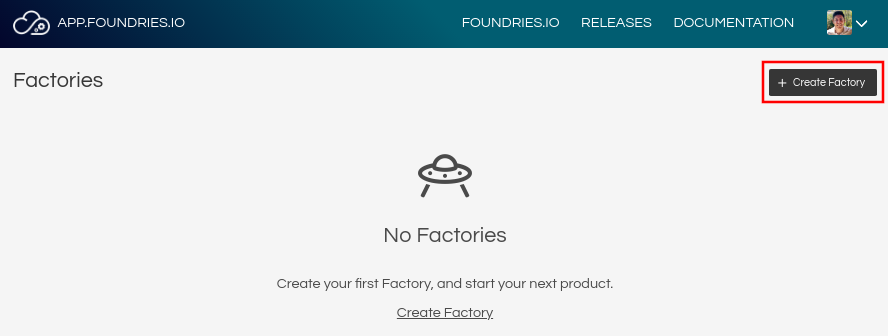Signing Up¶
To begin using FoundriesFactory®, start with creating an account with us.

Fig. 1 This is the beginning of your journey.¶
Creating Your Factory¶
FoundriesFactory is the start of your embedded OS, tailored specifically for your product. When you create a Factory, we immediately bootstrap the CI build process. This generates a vanilla, unmodified Linux microPlatform OS Image, which is from this point onward, owned by you.
When your account is created, it is not associated with any factories. Create one by clicking Create Factory.

Fig. 2 Your journey begins empty handed¶
Selecting Your Platform¶
Choose a hardware platform from the dropdown menu in the Create Factory wizard and continue. Click Create Factory once your details are entered.
Warning
Once a Factory is created, the chosen platform/machine and Factory name cannot be changed. Create a new Factory or contact support if a mistake is made: https://support.foundries.io/.
The Linux microPlatform supports a wide range of platforms out of the box. This includes QEMU images for ARM and RISC-V architectures.

Fig. 3 Create Factory¶
Tip
Your chosen platform determines the value for the machines: key for your builds.
Watching Your Build¶
Once you have created your Factory, the initial builds of the Foundries.io™ Linux® microPlatform (LmP) will be generated. This is the base to build your product. You can monitor the progress of builds in the Targets tab of your Factory after a few minutes. Additionally, you will receive an email once the initial builds are complete.

Fig. 4 FoundriesFactory Targets¶
Targets are a reference to a platform image and Docker applications. When developers push code, FoundriesFactory produces a new target. Registered devices then update and install Targets.
Note
If you would like to learn more, we wrote a blog about what Targets are and why we made them the way they are.
The Targets tab of the Factory will become more useful as you begin to build your application and produce new Targets for the Factory to build.
Hint
Bootstrapping your Factory securely takes some time. Your first build will likely take 30 minutes or more to complete.
Use this time to set up your development environment and get started with Docker commands. These guides do not require any hardware: